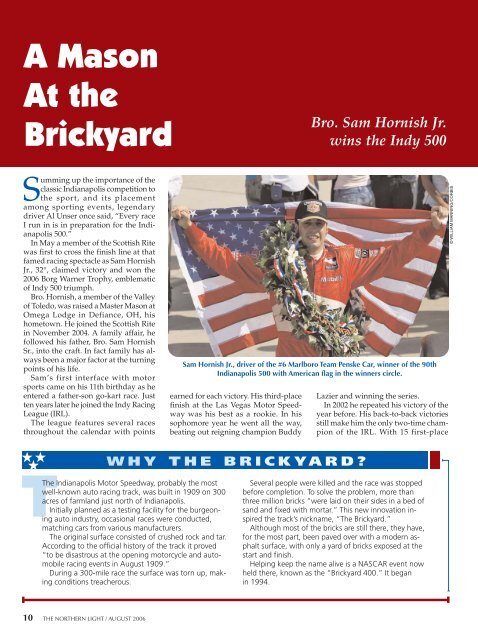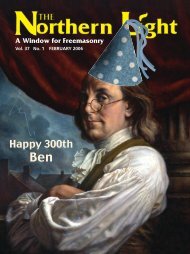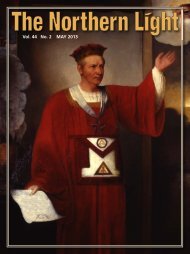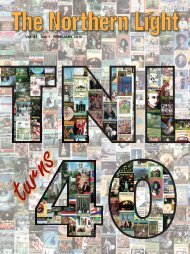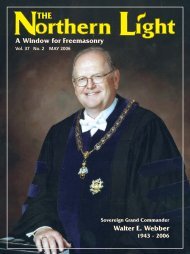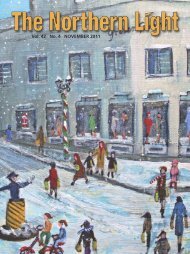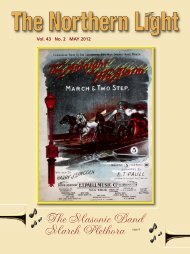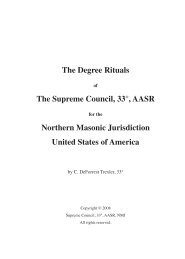A Window for Freemasonry - Scottish Rite
A Window for Freemasonry - Scottish Rite
A Window for Freemasonry - Scottish Rite
You also want an ePaper? Increase the reach of your titles
YUMPU automatically turns print PDFs into web optimized ePapers that Google loves.
A Mason<br />
At the<br />
Brickyard<br />
Bro. Sam Hornish Jr.<br />
wins the Indy 500<br />
Summing up the importance of the<br />
classic Indianapolis competition to<br />
the sport, and its placement<br />
among sporting events, legendary<br />
driver Al Unser once said, “Every race<br />
I run in is in preparation <strong>for</strong> the Indianapolis<br />
500.”<br />
In May a member of the <strong>Scottish</strong> <strong>Rite</strong><br />
was first to cross the finish line at that<br />
famed racing spectacle as Sam Hornish<br />
Jr., 32°, claimed victory and won the<br />
2006 Borg Warner Trophy, emblematic<br />
of Indy 500 triumph.<br />
Bro. Hornish, a member of the Valley<br />
of Toledo, was raised a Master Mason at<br />
Omega Lodge in Defiance, OH, his<br />
hometown. He joined the <strong>Scottish</strong> <strong>Rite</strong><br />
in November 2004. A family affair, he<br />
followed his father, Bro. Sam Hornish<br />
Sr., into the craft. In fact family has always<br />
been a major factor at the turning<br />
points of his life.<br />
Sam’s first interface with motor<br />
sports came on his 11th birthday as he<br />
entered a father-son go-kart race. Just<br />
ten years later he joined the Indy Racing<br />
League (IRL).<br />
The league features several races<br />
throughout the calendar with points<br />
Sam Hornish Jr., driver of the #6 Marlboro Team Penske Car, winner of the 90th<br />
Indianapolis 500 with American flag in the winners circle.<br />
earned <strong>for</strong> each victory. His third-place<br />
finish at the Las Vegas Motor Speedway<br />
was his best as a rookie. In his<br />
sophomore year he went all the way,<br />
beating out reigning champion Buddy<br />
Lazier and winning the series.<br />
In 2002 he repeated his victory of the<br />
year be<strong>for</strong>e. His back-to-back victories<br />
still make him the only two-time champion<br />
of the IRL. With 15 first-place<br />
© WILLIAM MANNING/CORBIS<br />
★★<br />
T★ The Indianapolis Motor Speedway, probably the most<br />
well-known auto racing track, was built in 1909 on 300<br />
acres of farmland just north of Indianapolis.<br />
Initially planned as a testing facility <strong>for</strong> the burgeoning<br />
auto industry, occasional races were conducted,<br />
matching cars from various manufacturers.<br />
The original surface consisted of crushed rock and tar.<br />
According to the official history of the track it proved<br />
“to be disastrous at the opening motorcycle and automobile<br />
racing events in August 1909.”<br />
During a 300-mile race the surface was torn up, making<br />
conditions treacherous.<br />
Several people were killed and the race was stopped<br />
be<strong>for</strong>e completion. To solve the problem, more than<br />
three million bricks “were laid on their sides in a bed of<br />
sand and fixed with mortar.” This new innovation inspired<br />
the track’s nickname, “The Brickyard.”<br />
Although most of the bricks are still there, they have,<br />
<strong>for</strong> the most part, been paved over with a modern asphalt<br />
surface, with only a yard of bricks exposed at the<br />
start and finish.<br />
Helping keep the name alive is a NASCAR event now<br />
held there, known as the “Brickyard 400.” It began<br />
in 1994.<br />
10 THE NORTHERN LIGHT / AUGUST 2006


